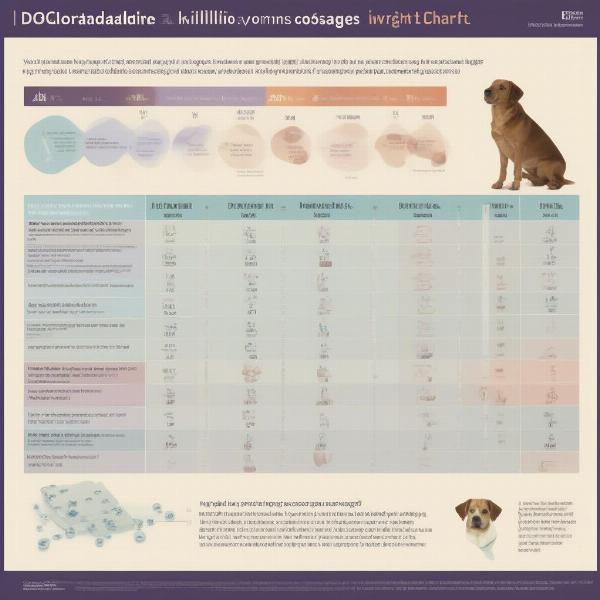Loratadine, an antihistamine commonly used for humans, is sometimes prescribed for dogs to manage allergic reactions. Understanding the correct dog loratadine dosage chart by kg is crucial for pet owners. Administering the wrong dosage can be ineffective or even harmful to your furry friend. This article will delve into safe loratadine usage for dogs, providing a comprehensive guide to dosage based on weight, potential side effects, and when to consult a veterinarian.
 Dog Loratadine Dosage Chart
Dog Loratadine Dosage Chart
Why Loratadine Might Be Prescribed for Your Dog
Just like humans, dogs can suffer from various allergies, including environmental allergies (pollen, dust mites, mold), food allergies, and flea allergies. These allergies can manifest in several ways, including itching, skin rashes, sneezing, and watery eyes. Loratadine works by blocking histamine, a chemical released by the body during an allergic reaction. This helps to alleviate the symptoms your dog experiences.
Dog Loratadine Dosage Chart by kg: A Safe Guide
While a general guideline exists, it’s imperative to consult with your veterinarian before administering any medication to your dog. They will be able to determine the appropriate dosage based on your dog’s specific needs, age, health status, and the severity of their allergies. A general guideline is 0.2mg per kg of body weight, usually given once or twice a day. For example, a 5kg dog would receive approximately 1mg of loratadine.
Loratadine for Small Dogs (Under 10kg)
For smaller breeds, accurate dosing is even more critical. Always use a syringe or specifically designed pet medication dispenser to ensure you administer the correct amount.
Loratadine for Medium to Large Dogs (Over 10kg)
While tablets might be easier to administer to larger dogs, ensure they are appropriately scored for accurate division if needed. Never give a human formulation without veterinary guidance due to potential inactive ingredients that could be harmful to dogs.
Potential Side Effects and Precautions
While generally safe, loratadine can cause side effects in some dogs, including:
- Dry mouth
- Drowsiness
- Increased heart rate
- Vomiting
If you notice any of these side effects, contact your vet immediately. Also, inform your veterinarian about any other medications your dog is taking, as loratadine can interact with certain drugs.
When to Consult a Veterinarian
Never self-diagnose or self-treat your dog’s allergies. Always consult your veterinarian for an accurate diagnosis and personalized treatment plan. If your dog’s symptoms worsen or don’t improve with loratadine, seek immediate veterinary attention.
Is Loratadine the Right Choice for My Dog?
Only your vet can determine if loratadine is suitable for your dog’s specific allergy. Other antihistamines or treatment options might be more effective depending on the underlying cause of the allergy.
What if I Miss a Dose?
If you miss a dose, give it as soon as you remember. However, if it’s close to the next scheduled dose, skip the missed dose and continue with the regular schedule. Never double dose to compensate for a missed one.
Conclusion
Understanding the dog loratadine dosage chart by kg is a significant step in managing your dog’s allergies. However, it’s paramount to remember that this information should not replace professional veterinary advice. Always consult your veterinarian for an accurate diagnosis, personalized dosage recommendations, and monitoring for potential side effects. By working closely with your vet, you can help your dog find relief from allergy symptoms and live a happier, healthier life.
FAQ
- Can I give my dog human loratadine? While the active ingredient is the same, human formulations may contain inactive ingredients harmful to dogs. Always consult your veterinarian before giving any human medication to your dog.
- What are the common signs of allergies in dogs? Itching, skin redness, excessive licking or chewing of paws, sneezing, and watery eyes are common allergy symptoms.
- How long does it take for loratadine to work in dogs? Loratadine typically takes effect within 1-2 hours.
- What should I do if my dog overdoses on loratadine? Contact your veterinarian or an emergency animal hospital immediately.
- Are there any alternative allergy treatments for dogs? Yes, there are several other antihistamines, as well as other treatment options like immunotherapy. Your veterinarian can help determine the best course of action for your dog.
- Can loratadine be used long-term for dogs? In some cases, yes, but it’s crucial to discuss long-term usage with your veterinarian.
- Can puppies take loratadine? Dosage and suitability for puppies should always be determined by a veterinarian.
We at ILM Dog are dedicated to providing pet owners with reliable and up-to-date information on all aspects of dog care. From breed selection and health to training and nutrition, we strive to empower owners with the knowledge they need to provide their furry companions with the best possible care. Need more advice? Contact our experts at [email protected] or call us at +44 20-3965-8624. Visit ILM Dog** at https://ilmdog.com for more resources and information.